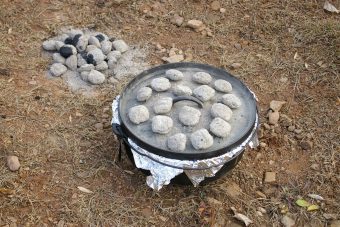 No one likes to be stuck in a sweltering kitchen on a hot sunny day. When the weather is gorgeous, summer evenings should be spent outside, not slaving away over air-polluting kitchen appliances. A recent study from California has brought to light just how toxic kitchen appliances can be. Gas powered ovens were found to put a lot of dangerous chemicals into the air without homeowners being aware of it. Though the Environmental Protection Agency (EPA) cracks down on industrial pollution, they don’t have an effective way to monitor pollution levels in the home environment, meaning that the levels of toxins that build up in well-used kitchens can reach staggeringly unsafe levels without families having a clue.
No one likes to be stuck in a sweltering kitchen on a hot sunny day. When the weather is gorgeous, summer evenings should be spent outside, not slaving away over air-polluting kitchen appliances. A recent study from California has brought to light just how toxic kitchen appliances can be. Gas powered ovens were found to put a lot of dangerous chemicals into the air without homeowners being aware of it. Though the Environmental Protection Agency (EPA) cracks down on industrial pollution, they don’t have an effective way to monitor pollution levels in the home environment, meaning that the levels of toxins that build up in well-used kitchens can reach staggeringly unsafe levels without families having a clue.
Think of it this way, if your house was a public space, the EPA might be knocking on your door. Without proper ventilation, gas ranges can produce air pollution levels that far exceed what is considered safe for people to breath in. The scientists behind this study were so disturbed by their research findings that they believe it should become a public health priority to educate the public about the air pollution dangers of cooking over gas stoves.
Don’t be a victim of your own home’s pollution. There are steps you can take right now to reduce your exposure to toxic indoor chemicals. One fantastic option is to occasionally move your cooking process to the backyard. Making your food outside can be an enjoyable, low-cost way to cook that’s as fun to do as the results are to eat. Best of all, these four techniques require no fuel source besides the sun and a little bit of firewood.
So step outside that sweaty kitchen, enjoy the outdoors, and have some fun experimenting with different ways to make dinner.
Preserve nutrients with a solar dehydrator
 The freezer works when you have electricity, but how could you hope to preserve your garden produce if the power goes out? Dehydrating food is an age-old process that prevents bacteria from spoiling your food while retaining nutrients, all without relying on added salts and sugars. Don’t think of solar drying as merely a hobby; it can revolutionize the way you approach your food.
The freezer works when you have electricity, but how could you hope to preserve your garden produce if the power goes out? Dehydrating food is an age-old process that prevents bacteria from spoiling your food while retaining nutrients, all without relying on added salts and sugars. Don’t think of solar drying as merely a hobby; it can revolutionize the way you approach your food.
Electric counter top dehydrators are noisy, energy-sucking devices, so consider using a solar dehydrator instead! There are lots of variations in design, but a basic model uses plywood and is essentially made of two parts: a heat collector and dehydrator box. Food is thinly sliced and positioned on screen trays so that warm air can hit each piece from every angle. Sunlight passes through the clear glass top of the dehydrator box and the heat gets trapped inside, working to dry the food pieces inside it. Some dehydrators also contain an absorber plate that indirectly heats the food while removing excess moisture from the system.
For best success, make sure to dehydrate food when it is at peak ripeness in order to get maximum flavor and nutrients out of it. You can expect a moisture-rich food like tomatoes to take two days to dry in a system like this.
There are a few things that are important to keep in mind when planning to use a solar dehydrator. First, remember that multiple sunny days in a row are usually necessary for getting your food completely dry. Food might spoil in the dehydrator box if the sun goes away for too long. Also, keep in mind that recipes taste different when prepared with dehydrated food. They won’t taste worse, they’ll just have a different texture and consistence. Cooking time will also go up because it takes a while for dehydrated food to regain moisture. But, if you can work around these obstacles, you will find that solar dehydrators are an innovative, dead easy way to get yourself some cooking time outside of the kitchen.
Need a little more advice? This link will tell you what you need to know.
In summary
Cooking dinner doesn’t have to happen between four walls and a roof. Take the initiative to step outside and you might find that your most innovative and delicious recipes will be created under the inspiration of the open air. Once you’ve tasted home-fired pizza from your earth oven or eaten a savory stew straight from a Dutch oven, you might find that your regular kitchen no longer holds the same appeal.
Be bold. Go outside. A whole world of fossil-fuel-free culinary experimentation awaits you.
Source: naturalcave.com

